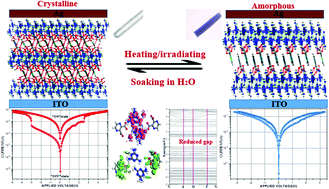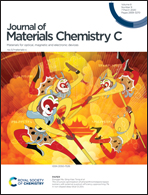Reversible photo/thermal stimuli-responsive electrical bistability performance in supramolecular co-crystals accompanied by crystalline-to-amorphous transformations†
Abstract
Stimuli-responsive electrically bistable devices are significant for the development of new generation memory materials. In this study, a co-crystal, (MA-H)2(PZDC)·4H2O (MA = 1,3,5-triazine-2,4,6-triamine, melamine; H2-PZDC = pyrazine-2,3-dicarboxylate), was firstly fabricated as an active layer to prepare an ITO/(MA-H)2(PZDC)·4H2O/Ag device, which exhibits switchable conductivity states with an ON/OFF current ratio of 105. Interestingly, the electrical bistability performance can be quenched by heating and irradiating stimuli accompanied by reversible crystalline-to-amorphous transformations, which can be recovered by soaking the samples in water. Based on the crystal structures after heating/irradiation and theoretical calculations, a photo/thermal responsive electrical bistability switching mechanism was proposed: the decreased band gap caused by the disappearance of lattice water around PZDC2− will inhibit the formation of a countering space-charge field and consequently, the electrical bistability behaviors will vanish. This study paves a new way for the design of stimuli-responsive electrical bistability materials.



 Please wait while we load your content...
Please wait while we load your content...